 I can remember back to the days of my childhood, when my mother would repeatedly scold me for yanking on the cord of electronic devices to unplug them. “David Carl Miller”, she would say – you knew you were in trouble when the middle name was used – “pull it form the plug, not from the cord.”
I can remember back to the days of my childhood, when my mother would repeatedly scold me for yanking on the cord of electronic devices to unplug them. “David Carl Miller”, she would say – you knew you were in trouble when the middle name was used – “pull it form the plug, not from the cord.”
Fast forward 20 years and, as it turns out, that was actually good advice. One evening after work this week, I pulled into the garage and noticed our iron sitting on my workbench. That didn’t seem good. The iron was of pretty good quality, and my wife and I had bought it a few years back, shortly after getting married. We purchased it after doing a modest amount of research, reading reviews, comparing specifications and features. etc. For us, this one edged out a Rowenta with similar features because it was less expensive.
I went into the house to ask my wife what had happened and, sure enough, it was broken. I won’t name names, but someone had allegedly yanked the cord out of the wall by pulling on the iron itself (and no, it wasn’t my wife). Apparently now you had to “hold up” the cord to make the iron stay on.
Thinking that it would be a pretty easy task to fix it, I decided that I’d give it a go.
Big Disclaimer
Irons are a common cause of household fires, especially if they are repaired incorrectly. I have no idea whether or not the solution below increases the risk of fire from this model of iron. These irons are designed by the manufacturer to be non-serviceable. Also, I have never been to Black and Decker Iron Repair School. Therefore, the information that follows is intended only to be interesting reading that also happens to be really good at putting people to sleep. Should you choose to repair your iron in a similar fashion, I cannot be responsible for any issues that arise as a result of the repairs described below.
Reproducing the Problem
Before I started, I plugged in the iron in to see if I could reproduce the behavior. Sure enough, within a few seconds of plugging in the iron, it shut off. It seemed that moving the base of the cord (where it entered body of the iron) to the left or top would cause the iron to come on, and moving the cord to the right or down would cause it to go off. It seemed like a cord problem, so I took a quick look at the cord. I saw what looked like one small crimp near the plug end of the cord, but wiggling this around didn’t seem to matter. Only wiggling the cord near the base would make it shut off.
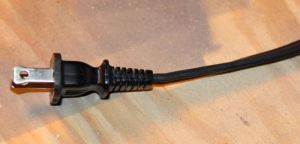
The picture doesn’t do it justice, but there is a small “crimp” irregularity near the place where the cord meets the plug.
Nothing else on the cord looked suspect, so the problem seemed to be within the body of the iron. Trying to save myself some time, I did some quick searching on the internet, and came across this post describing a similar problem. In that post, replacing the power cord resolved the issue, so at this point I was hoping for the same.
Tools
After reading that post, I learned that the only way to get into the iron was with a security screwdriver bit. Specifically, the bit needed is called a “spanner” bit. A few minutes more of research turned up the Klein 32510 Magnetic Screwdriver with 32-Piece Tamperproof Bit Set, which was rated pretty highly, and had four different sizes of spanner bits. Surely that would give me what I needed. I didn’t already have a screwdriver handle that worked with interchangeable bits, but the bits are also available by themselves.

Need to take apart things you aren’t supposed to take apart? Then the Klein 32510 is the screwdriver for you!
In addition to the screwdriver, I decided to buy the Donegan DA-5 OptiVisor Headband Magnifier. There were several reasons for this…
- My eyesight keeps getting worse as I
get olderkeep staring at computer screens all day long. - I work on quite a few projects that require looking at small objects.
- The documentation says that it “increases your efficiency”.
- The documentation implies that I will look as cool as the guy on the cover when I am wearing the device.
Then I unscrewed both security screws from the translucent cover.
Once that was done, I had to pop off the edges using a thin flat blade screwdriver.
After the decorative cover was off, I needed to remove the inner cover. Squeezing the handle with several of my fingers while pushing toward the base of the iron (to the right in the picture below) with my thumb and index finger seemed to do the trick.
Removing the Cord
Now that the back panel was removed, I needed to remove the cord itself. There are several wires in here, but they aren’t too bad if you remember to label them as you go.
The first step in removing the cord is to get the wire nuts (the little white plastic covers) off of the wires. The only two needed to be removed were the ones that have the thick black wires of the power cord in them. To get them off, I used some needle-nosed pliers to crush the wire nut along its long side. This opened up the small piece of metal inside that was crimping the wires together, allowing the wire nut to be removed.

Use pliers to smash the wire nuts along their long axis in order to get them off of the wires they are holding in place.
The purpose of these wire nuts is to both hold several wires together and keep them from touching other wires. Thinking it would generally be a good idea to make the same wires go back in the same wire nuts at the end of the day, I decided to put labels around all of the non-power cord wires that were in each nut. Using a unique and strange convention, I labeled the one on the right “R”, and the one on the left “L”.

Labeling the wires is a good idea, so that you don’t have to remember them later. Another way to do it is to look at photographs in blog posts.
Now that everything was labeled, I removed the small white piece of plastic that was holding the power cord in place. A small Phillips screwdriver did the trick.
Now that the cord was free, I pulled it out of the big plastic ring through which it was threaded.
Fixing the Cord
Upon untying the cord and inspecting it, I found my problem. There was an bad crimp in the cord just a few centimeters away from the place where the knot was tied.
I cut the cord just on the far side of the crimp, and carefully split and stripped the short wire (the bad one with the crimp still in it) on the other side of the crimped spot to see if the wire was broken inside. As I had expected, it was indeed broken. This would have explained why the iron would come on and go off when you wiggled the cord into different positions. Some positions would cause the broken wire to touch itself, reestablishing the connection, and other positions would separate it, breaking the connection.
Since not much of the cord had to be cut off, I could thankfully just strip and reuse the same cord. If the problem had occurred in the middle of it, I would have been hesitant to cut out the bad part and splice back the two good parts of the cord. The main reasons being that pigtail splices look ugly on consumer electronic devices, and inline splices would be two weak to stand up to any kind of further cord-pulling from the iron-person.
Instead of splicing, in that case, I would have tried to find a really long replacement cord either scavenged from other junk in my garage, or purchased online. One really important thing to note in that situation is that I would have to have found or purchased a wire with a gauge number equal to or lower than the one printed in writing on the side of the existing power cord (16-gauge or 16AWG on my iron). The reason for that is that lower-numbers on the wire gauges mean that they are thicker wires, and can handle more current before becoming hot, melting, or otherwise having generally bad things happen. Since I didn’t do any kind of analysis on how much current the iron was moving through that wire, there would have been no way for me to ensure that a thinner wire would be safe.
But, I digress. The point is just to not use thin wires if you do it yourself. Since I could still use the long part of my existing wire, and didn’t need a replacement cord, I used I knife to cut the insulation connecting the two wires down just a couple of centimeters from the end of the cord.
Next, I used a pair of wire strippers to strip each of the two wires in the cord. Good wire strippers will have clearly defined labels next to each “hole” indicating the gauge of the wire you need to strip. My wire strippers are not good, and I have no idea what the markings on them mean. I paid exactly $0.99 for them at one of those fly-by-night stores that appear in the mall around Christmas time.
Reattaching the Cord
Now that the “good” part of the cord had separated and stripped wires on the end, I could reattach it to the body of the iron. To do so, I tied a knot approximately the same distance from the end of the cord that it was originally. It took a couple of attempts to get it right, but eventually I got it so that the lengths of the separated wires below the knot were of a length that would reach the other wires.

Tie the knot back so that the wires from the cord can easily make contact with the other wires that were previously labeled.
Next, it was time to reattach the white plastic clamp that holds the cord securely in the iron. I now had two sets of screws. The correct ones to use were the Phillips ones that had flat business ends. The ones with the security heads and the pointy ends were for the decorative cover.
I used my small Phillips screwdriver to screw the clamp back in place. I had to take care to ensure that the cord was flat against the clamp or else it may have caused another crimp.
Upon finishing the clamp installation, it was time to reconnect the power cord wires to the other wires. I removed my “R” label, and twisted those wires together with the right power cord wire. Similarly, I then took the wire underneath the “L” label, and twisted it together with the left power cord wire.
The Moment of Truth – Testing the Iron
If there is one thing I have learned in working with technology, whether it be computer software, computer hardware, consumer electronics, or whatnot, is that you can save a ton of work by testing early and testing often. It saves work, and being able to fail fast and get quick feedback gives you a much better chance to learn from your mistakes and get better at whatever it is that you are trying to do (I guess to be a better iron-repairer in this case).
This was about the earliest place I could test to see if what I did made a difference. If this didn’t work now, I could check other things, throw the iron away and buy a new one, ask for help from someone smarter or more experienced than myself, etc.
If instead, I had tested only after putting the back plate on and closing things up, a failure would have been much more frustrating. I would have had to take the translucent decorative cover and inner cover off again.
So, I plugged in the iron….
… and it came on. Even after I wiggled the cord around, it stayed on. It looked like the fix worked!
Reattaching the Backplate
Now that I knew that I was making headway, and that reattaching the back plate wasn’t a waste of time, I went about that task. Before doing that, however, I needed to put the wire nuts back on the wires to ensure that they held together and (more importantly) that they didn’t accidentally touch other wires.
After looking at the original wire nuts, it became apparent that they weren’t going to work for me any more. My manual twisting of the wires together wasn’t nearly as elegant as the machines that had originally created the iron and, as a result, had produced a twisted set of wires that were now too thick to enter into the small opening inside the original wire nuts.
Luckily, I had several spares lying around. If I hadn’t, I could have picked some up at the local hardware store. I chose one big one for the right set of wires (as they were a bit thicker), and a small one for the left set of wires (as they were a bit thinner).
Another way to do this is with electrical tape. You can manually twist the wires together really well, and then wrap all exposed wire with electrical tape. The thing here again is that you have to be really careful not to let any wire be exposed. If you do, and it accidentally touches the wrong wire, it can cause the iron to overheat or catch on fire.
I pushed the wires I wanted together into the wire nuts and twisted in a clockwise (from the top) fashion, just as if I were screwing in a screw (righty-tighty, lefty-loosey, remember?). An important thing for me to remember here was to not over-tighten the nuts. If I did, it would have been possible to break off the ends of wires inside the nuts, and then I would have had to re-strip and re-twist them into the wire nuts.
To make sure that such a thing hadn’t happened, I again plugged in the iron to ensure that it was still working. Everything still seemed fine.
Next, I attached the inner cover. This was pretty easy, as it just snaps back on. I did have to bend the wires and wire nuts “up”, as my wire nuts were a little bigger than the originals and would not allow the inner cover to snap on if they were in the “down” position.
After that, I snapped the translucent decorative cover back on over the inner cover.
And then I used by fancy new screwdriver and security bit to attach the decorative cover and inner cover in a more permanent fashion.
And after testing once more – voilà! The iron was as good as new (with a slightly shorter cord).

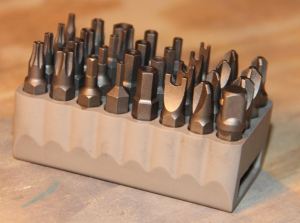
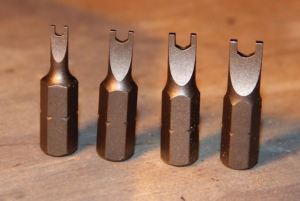





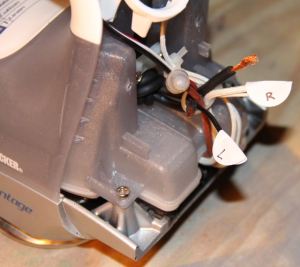




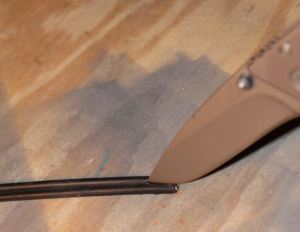

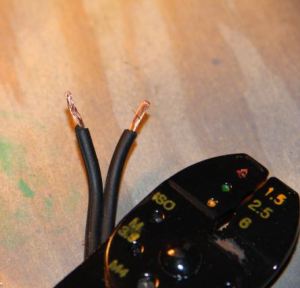

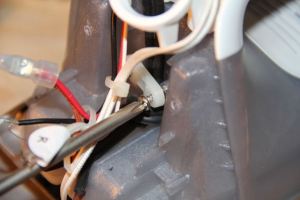
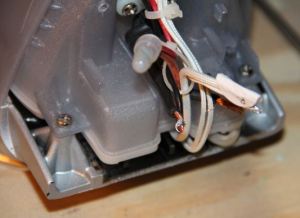
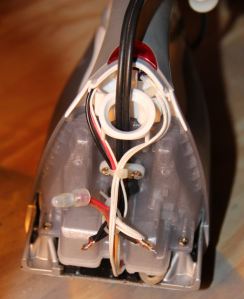

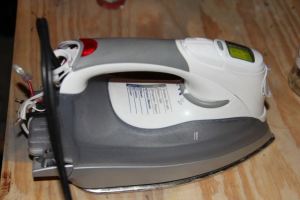

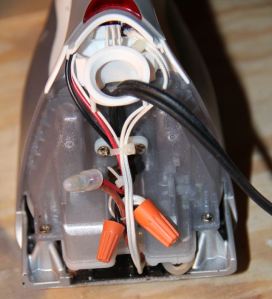

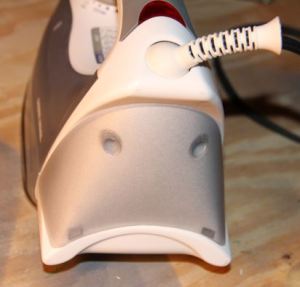

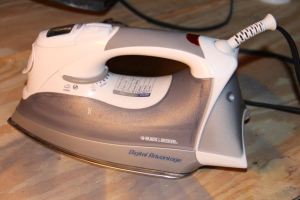
It’s a couple months later, but this was a great help to mend my slightly different Black and Decker model.
Appreciate this, no use throwing out a perfectly good iron for such a little defect.
Thanks!
My D2030 has stopped working after a fortnight… I am unable to return for warranty due to the cost of shipping back from Australia. Is there a “thermal fuse” that may be able to be replaced that you noticed while having your iron disassembled?
David,
I didn’t notice a thermal fuse when I had the iron open, but that doesn’t mean I didn’t overlook it. If there is one, my guess would be that it is in the top assembly that I didn’t have opened. Since it’s already broken there shouldn’t be too much harm in taking it apart and looking around if you have the time.
What’s the exact size of the spanner bit you used? I believe it would be etched into the bit itself. Thanks in advance!!!!
Chris,
The spanner bit I used is the largest one available in the Klein set that I purchased – a size 10.
Check out the product details by clicking below for more information…
I own a B&D steam advantage AS145. When I plugged in yesterday, the lights are on but the plate is not hitting up, I tried several out lets but the results are same, it is not heating up to iron. It is almost 10 years old, any advice? other than buying a new one.
Shawn,
I don’t have any specific advice, but I’d definitely crack it open and make sure that the heating element has power. It could be something as simple as a broken connection.
great post! as it happens my friend’s dog just ate my brand new iron’s chord and i felt like it would be a huge waste and not environmental friendly to buy a brand new one just fort that. Just ordered the tools and will fix it this week.
Nice photos and good narrative. I just repaired my Black & Decker AS 145 tonight which had the same type of problem. You are correct. The manufacturer does not design these products to be repaired. Thanks for the time you put into this explanation.
Thanks for a great post, and I love the humor too! I’m about to repair the same exact problem on my iron. Just one question, unless I’m missing something, how do I know which is the right or left on the power cord?
Hi Joel! I suspect you are referring to labelling the wires as “left” and “right”. It doesn’t actually matter which is left and right. The iron really only cares about the potential difference (voltage) across the two wires. I just used left and right to try and keep track of how best to get the wire nuts back into the iron. The important part is to make sure that all of the same wires that were originally touching each other continue to do so after you finish.
Dear David,
Thank you so much for the extremely instructive post. My husband and I followed it to repair the same iron with the same problem. As my husband does not own a #10 spanner bit, he made his own similar bit by sawing and filing a flathead screw bit to match, and it worked brilliantly!
Jane,
Great! I’m glad to hear that it worked out for you. Kudos to your husband on an innovative and less expensive solution to getting around the security screws.
you scared me with the fire reference (yes, I’m a girl). Off to buy a new iron!
Thanks Racingcow.
I had a slightly different B&D model, but, your instructions were absolutely clear and I had no problem doing the repair… Greatest difficulty was actually finding the spanner bits in Toronto. No luck at Canadian Tire and Home Depot, but, finally lucked out at Rona.
Much appreciated.
Jay.
This is great!. I had exactly the same problem on the same iron two years ago and ended buying a new iron, because I could not open the back cover. I wish I had seen this posting. Regardless, I saved the iron hoping to fix it someday. Now it is fixed and I have two good working irons, but I am not complaining.:-)
Thanks so much. I just fixed my iron having the same problem. Great job describing the step by step procedure. Saved me tons of time and errors.
Good instructions. If it makes you feel any better about not buying the cheaper brand, I juat had to make the same repair to my Rowenta.
One question: any concern about using the standard electrical wire nuts? Do you think they will withstand the same temperatures? I don’t really think that part of the iron gets very hot, but wasn’t sure.
Harvey,
I think it should be fine to use standard electrical wire nuts. The heating element shouldn’t warm that part of the iron, and I wouldn’t have any concerns about using them.
Thank you so much for taking the time to do this – saved money as well as prevented another throw-away item!
I have a d3030
Instead of purchasing the spanner set, I simply found a cheap slot driver, and with a Dremel cutoff wheel cut a small notch into the middle of driver bit. Anyway, my question is if there is a motion sensor inside the iron and if it can be replaced, also its placement. The iron turns off while I’m using it every ten minutes. I would appreciate any thoughts.
I’m sure there is one in there somewhere, and it should be replaceable. Sorry for the lack of detail, but it was quite a while back when I opened it up, and I don’t remember seeing it when I had the case open.
I read a couple of complaints on this problematic iron but haven’t seen a scheme to do repair. The iron would turn off by itself after 10 minutes regardless of it being in motion or not. Then when you turn back on the iron would blow out water and steam thru the steam hole and sometimes calcium deposits onto clothes being ironed. Thank you for previous answer and terrific illustration on doing cord repair. I also wanted to add a comment when I previously came upon a screw as such and how I attacked the problem. Best tom.
Even now, your great advice has been incredibly helpful as I was able to fix my wife’s iron fairly easily. Only had to schlepp to Home Depot to find a $2.50 #10 spanner bit. Thanks much!
excellent posting. What about when the steam setting wheel is stuck and will not turn from the no steam setting.
A Rafiq,
Unfortunately, I don’t have any experience in the steam setting wheel. I suspect you could disassemble the iron and determine what is making it stick, however.
-David
A Rafiq: Please let me know if you find out how to repair the variable steam dial as mine is stuck also! My B&D Model D2030 was purchased 10/2011 so I can’t complain too much since it’s lasted much longer than more expensive irons. I can still steam by using the push steam button on the top which is typically used for vertical steaming.
Thank you very much for this step by step tutorial, I had the same problem and thanks to you I fixed the problem myself, thanks again cheers.
Excellent write up. Very helpful. The iron I’m dealing with has a spline head screw. A 25 piece security bit set will probable have one that fits. Modern power cords and plugs are polarized. One blade of the plug the plug is wider than the other also one side of the cord will have printing or a ridge along it. If you observe that and mark it then all will be as originally built. If the old cord on an old, old iron is cloth with white fiberous insulation it probable has asbestos. Sell it to antique dealer and buy on with the modern safty features like tip over protection, overheat protection and time out. Cord failures at the ends are common on other appliances like mixers, hair drivers and curling irons. They can be fixed the same way. ‘No user serviable parts inside’ is a challenge not a warning.
Thank you. I had exactly the same problem on my B&D model 2020, broken wire a few inches down the cord. Your well documented blog helped us get inside the casing with the proper tools and get it fixed in no time.
We noticed the exact same problem in our iron; very similar model from Black and Decker (digital advantage). I decided to open it up, couldn’t really find any issues, stumbled upon your posts, took another look and sure enough, exact same crimping issue on the main wire!! Cut the wires (thank you for the tip of labeling the wire, I also did just one side at a time, just to be sure), shortened it, got it all back together and it works perfectly again!! Thank you so much for posting this; not only did you save me a trip to the Bed Bath and Beyond here in COVID-ridden Florida, you also made me feel like a true mechanic (I’ll let you know if the house burns down) and you saved one iron from ending up at the landfill prematurely (1-0 for nature, and hopefully by the time this iron really meets its maker, Florida’s figured out how to join the rest of the world in this novel thing called recycling…).
That’s great, @Maarten ! I’m glad I could be of help, and that you were able to repair your iron.
I over-filled our D2030 and the excess water shorts out the controls inside. The iron will come on and heat up when standing upright but goes off when put into working position. Any ideas on how to open up the iron beyond the description here, so I can try to dry off the inside?